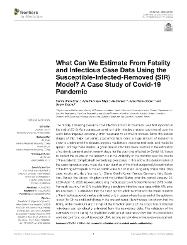What Can We Estimate From Fatality and Infectious Case Data Using the Susceptible-Infected-Removed (SIR) Model? A Case Study of Covid-19 Pandemic
| dc.contributor.author | Ahmetolan, Semra | |
| dc.contributor.author | Bilge, Ayşe Hümeyra | |
| dc.contributor.author | Demirci, Ali | |
| dc.contributor.author | Peker-Dobie, Ayşe | |
| dc.contributor.author | Ergönül, Önder | |
| dc.date.accessioned | 2020-11-30T14:16:16Z | |
| dc.date.available | 2020-11-30T14:16:16Z | |
| dc.date.issued | 2020 | |
| dc.identifier.issn | 2296-858X | en_US |
| dc.identifier.uri | https://hdl.handle.net/20.500.12469/3492 | |
| dc.identifier.uri | https://doi.org/10.3389/fmed.2020.556366 | |
| dc.description.abstract | The rapidly spreading Covid-19 that affected almost all countries, was first reported at the end of 2019. As a consequence of its highly infectious nature, countries all over the world have imposed extremely strict measures to control its spread. Since the earliest stages of this major pandemic, academics have done a huge amount of research in order to understand the disease, develop medication, vaccines and tests, and model its spread. Among these studies, a great deal of effort has been invested in the estimation of epidemic parameters in the early stage, for the countries affected by Covid-19, hence to predict the course of the epidemic but the variability of the controls over the course of the epidemic complicated the modeling processes. In this article, the determination of the basic reproduction number, the mean duration of the infectious period, the estimation of the timing of the peak of the epidemic wave is discussed using early phase data. Daily case reports and daily fatalities for China, South Korea, France, Germany, Italy, Spain, Iran, Turkey, the United Kingdom and the United States over the period January 22, 2020-April 18, 2020 are evaluated using the Susceptible-Infected-Removed (SIR) model. For each country, the SIR models fitting cumulative infective case data within 5% error are analyzed. It is observed that the basic reproduction number and the mean duration of the infectious period can be estimated only in cases where the spread of the epidemic is over (for China and South Korea in the present case). Nevertheless, it is shown that the timing of the maximum and timings of the inflection points of the proportion of infected individuals can be robustly estimated from the normalized data. The validation of the estimates by comparing the predictions with actual data has shown that the predictions were realized for all countries except USA, as long as lock-down measures were retained. | en_US |
| dc.language.iso | eng | en_US |
| dc.publisher | Frontıers Medıa Sa | en_US |
| dc.rights | info:eu-repo/semantics/openAccess | en_US |
| dc.subject | COVID-19 | en_US |
| dc.subject | SIR model | en_US |
| dc.subject | Parameter estimation | en_US |
| dc.subject | Mathematical models | en_US |
| dc.subject | Epidemiology | en_US |
| dc.title | What Can We Estimate From Fatality and Infectious Case Data Using the Susceptible-Infected-Removed (SIR) Model? A Case Study of Covid-19 Pandemic | en_US |
| dc.type | article | en_US |
| dc.relation.journal | Frontıers in Medıcıne | en_US |
| dc.identifier.volume | 7 | en_US |
| dc.department | Fakülteler, Mühendislik ve Doğa Bilimleri Fakültesi, Endüstri Mühendisliği Bölümü | en_US |
| dc.identifier.wos | WOS:000572507000001 | en_US |
| dc.identifier.doi | 10.3389/fmed.2020.556366 | en_US |
| dc.identifier.scopus | 2-s2.0-85091029096 | en_US |
| dc.institutionauthor | Bilge, Ayşe Hümeyra | en_US |
| dc.institutionauthor | Peker-Dobie, Ayşe | en_US |
| dc.relation.publicationcategory | Makale - Uluslararası Hakemli Dergi - Kurum Öğretim Elemanı | en_US |
| dc.identifier.pmid | 33015109 | en_US |
Files in this item
This item appears in the following Collection(s)
-
Endüstri Mühendisliği Bölümü Koleksiyonu [117]
Department of Industrial Engineering Collection -
PubMed İndeksli Yayınlar Koleksiyonu [378]
PubMed Indexed Publications Collection -
Scopus İndeksli Yayınlar Koleksiyonu [2197]
Scopus Indexed Publications Collection -
WoS İndeksli Yayınlar Koleksiyonu [2113]
WoS Indexed Publications Collection
















